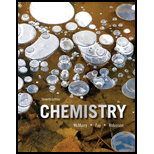
Concept explainers
Interpretation:
To draw as many resonance structures using curved arrows that obey the octet rule for each of the following molecules or ions:
- HN3 (b) SO3 c) SCN—
Concept introduction:
Resonance structures:
An organic compound does not have any single Lewis structure, the true structure is intermediate in between two three Lewis structures. These intermediate structures are called resonance structures.
Resonance structures are created by the moving of electrons but not moving of atoms.
Rules to draw resonance structure:
Rule 1: The placement of atoms and single bonds are stay at same position. The resonance structures differ in their position of multiple bonds and non bonded electrons.
Rule 2: All resonance structures of particular compound must have same number of unpaired electrons.
Rule 3: Resonance structures must be valid Lewis structures.
a)
To determine:
Resonance structure of HN3
b)
To determine:
Resonance structure of SO3
c)
To determine:
Resonance structure of SCN-
Want to see the full answer?
Check out a sample textbook solution
Chapter 7 Solutions
Chemistry (7th Edition)
 ChemistryChemistryISBN:9781305957404Author:Steven S. Zumdahl, Susan A. Zumdahl, Donald J. DeCostePublisher:Cengage Learning
ChemistryChemistryISBN:9781305957404Author:Steven S. Zumdahl, Susan A. Zumdahl, Donald J. DeCostePublisher:Cengage Learning ChemistryChemistryISBN:9781259911156Author:Raymond Chang Dr., Jason Overby ProfessorPublisher:McGraw-Hill Education
ChemistryChemistryISBN:9781259911156Author:Raymond Chang Dr., Jason Overby ProfessorPublisher:McGraw-Hill Education Principles of Instrumental AnalysisChemistryISBN:9781305577213Author:Douglas A. Skoog, F. James Holler, Stanley R. CrouchPublisher:Cengage Learning
Principles of Instrumental AnalysisChemistryISBN:9781305577213Author:Douglas A. Skoog, F. James Holler, Stanley R. CrouchPublisher:Cengage Learning Organic ChemistryChemistryISBN:9780078021558Author:Janice Gorzynski Smith Dr.Publisher:McGraw-Hill Education
Organic ChemistryChemistryISBN:9780078021558Author:Janice Gorzynski Smith Dr.Publisher:McGraw-Hill Education Chemistry: Principles and ReactionsChemistryISBN:9781305079373Author:William L. Masterton, Cecile N. HurleyPublisher:Cengage Learning
Chemistry: Principles and ReactionsChemistryISBN:9781305079373Author:William L. Masterton, Cecile N. HurleyPublisher:Cengage Learning Elementary Principles of Chemical Processes, Bind...ChemistryISBN:9781118431221Author:Richard M. Felder, Ronald W. Rousseau, Lisa G. BullardPublisher:WILEY
Elementary Principles of Chemical Processes, Bind...ChemistryISBN:9781118431221Author:Richard M. Felder, Ronald W. Rousseau, Lisa G. BullardPublisher:WILEY





